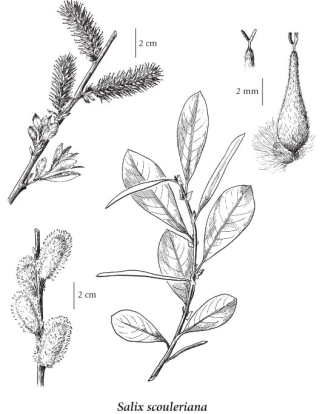Salix scouleriana Barratt ex Hook.
Scouler's willow (mountain willow)
Salicaceae (Willow family)
Introduction to Vascular Plants
Scouler's willow (mountain willow)
Salicaceae (Willow family)
Introduction to Vascular Plants
Species Information
General:
Dioecious shrubs or trees, 3-20 m tall, not colonial; branches erect, flexible at base; twigs yellow-green to yellow-brown, sparsely to densely velvety-hairy.
Leaves:
Alternate, simple, narrowly elliptic to lance- or egg-shaped, 3-8.5 cm long, 1-3.6 cm wide, lower surface glaucous, silky to woolly hairy, becoming sparsely so, hairs white and rust-coloured, upper surface shiny, sparsely long soft-hairy becoming nearly smooth, midrib remaining hairy, margins entire or toothed, bases and tips pointed to rounded; leaf stalks without glandular dots at top; stipules leaflike.
Flowers:
Unisexual, lacking sepals and petals, borne in catkins which flower before leaves emerge, the catkins stout, unstalked; floral bracts dark or pale, hairs straight; stamens 2; ovaries 1, hairy; styles 0.2-0.6 mm long.
Fruits:
Capsules which split open to release the seeds, each of which is surrounded by a tuft of hairs; stalks 0.8-2.3 mm long.
Notes:
The lower leaf surface in this species displays 2 radically different forms of hairiness. Most commonly it has a sparse mixture of short, appressed, rust-coloured or white hairs, but forms that are densely woolly with long, wavy, erect to spreading, white hairs may occur in the same population. Both forms have velvety leaf stalks and twigs.
Illustration

If more than one illustration is available for a species (e.g., separate illustrations were provided for two subspecies) then links to the separate images will be provided below. Note that individual subspecies or varietal illustrations are not always available.
Illustration Source: The Illustrated Flora of British Columbia
USDA Species Characteristics
Flower Colour:
Yellow
Blooming Period:
Early Spring
Fruit/Seed characteristics:
Colour: Brown
Present over the Spring
Source: The USDA
Ecology
Ecological Framework for Salix scouleriana
The table below shows the species-specific information calculated from
original data (BEC database) provided by the BC Ministry of Forests and Range.
(Updated August, 2013)
The table below shows the species-specific information calculated from
original data (BEC database) provided by the BC Ministry of Forests and Range.
(Updated August, 2013)
| Site Information |
Value / Class |
||
|
Avg |
Min |
Max |
|
| Elevation
(metres) |
955 | 5 | 2370 |
| Slope
Gradient (%) |
21 | 0 | 262 |
|
Aspect (degrees) |
188 | 0 | 360 |
| Soil
Moisture Regime (SMR) [0 - very xeric; 4 - mesic; 8 - hydric] |
3 | 0 | 8 |
| Modal
Nutrient Regime
Class |
C | ||
| #
of field plots species was recorded in: |
2205 | ||
| Modal
BEC Zone Class |
SBS | ||
|
All BEC Zones (# of stations/zone) species was recorded in |
AT(1), BAFA(1), BG(5), BWBS(301), CDF(7), CWH(164), ESSF(184), ICH(335), IDF(213), IMA(1), MH(3), MS(193), PP(5), SBPS(59), SBS(492), SWB(63) | ||
|
Source:
Klinkenberg 2013
|
|||
Habitat and Range
Dry to moist open forests, thickets, clearings and edges of rivers and lakes in the lowland, steppe and montane zones; common throughout BC; N to AK, YT and NT, E to SK and S to SD, AZ, NM, and CA.Status Information
Synonyms
Synonyms and Alternate Names:
Salix brachystachys Benth.
Salix brachystachys var. scouleriana (Barratt ex Hook.) Anderss.
Salix capreoides Anderss.
Salix flavescens Nutt.
Salix flavescens var. capreoides (Anderss.) Bebb
Salix flavescens var. scouleriana (Barratt ex Hook.) Bebb
Salix nuttallii Sarg.
Salix nuttallii var. capreoides (Anderss.) Sarg.
Salix scouleriana
Salix scouleriana var. brachystachys (Benth.) M.E. Jones
Salix scouleriana var. coetanea C.R. Ball
Salix scouleriana var. crassijulis (Anderss.) Schneid.
Salix scouleriana var. flavescens (Nutt.) J.K. Henry
Salix scouleriana var. poikila Schneid.
Salix scouleriana var. thompsonii Ball
Salix stagnalis Nutt.